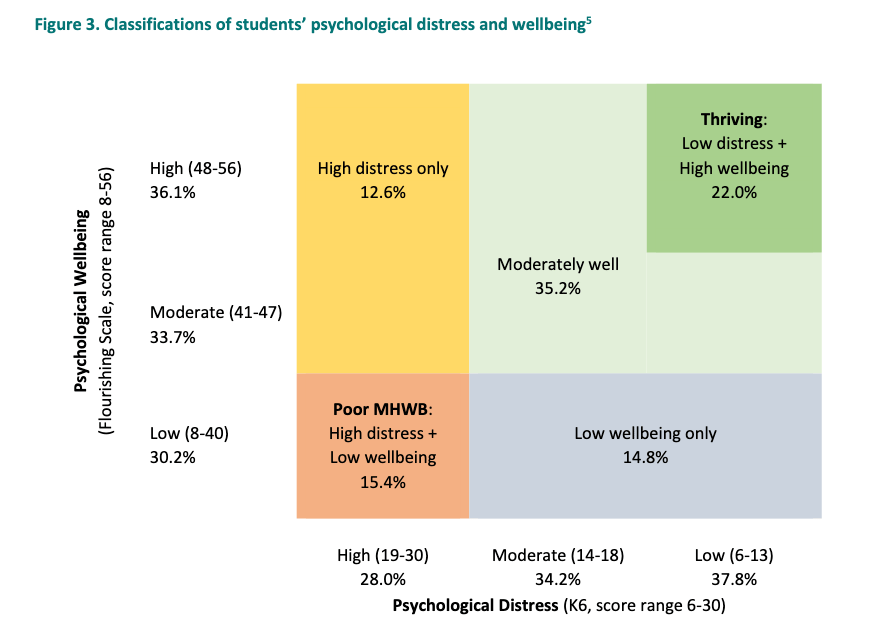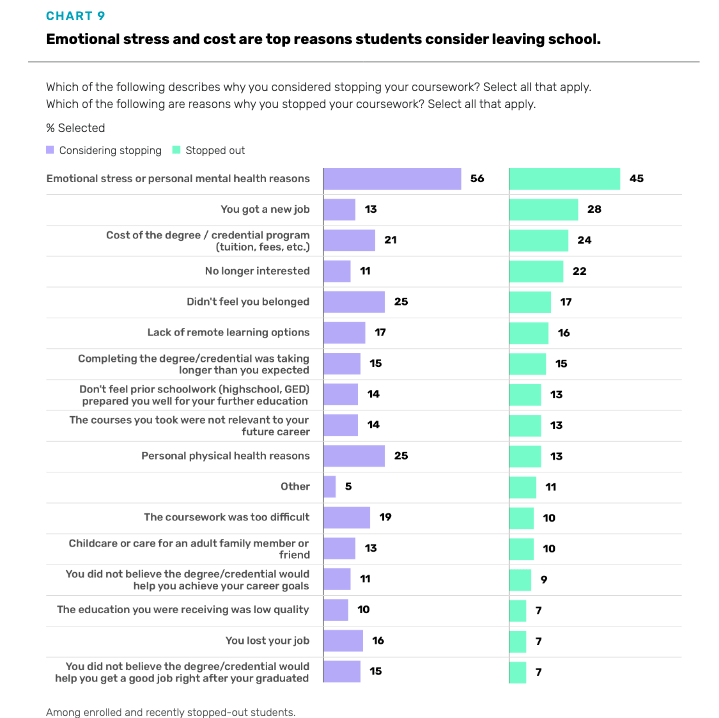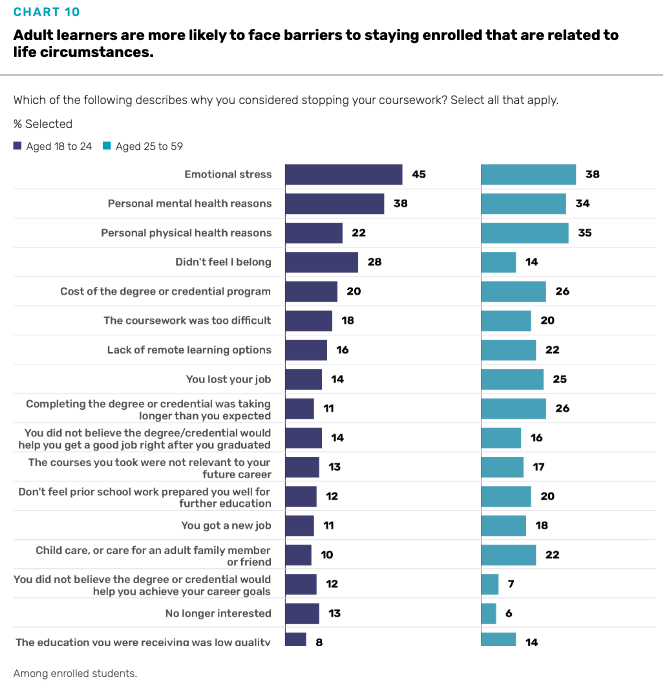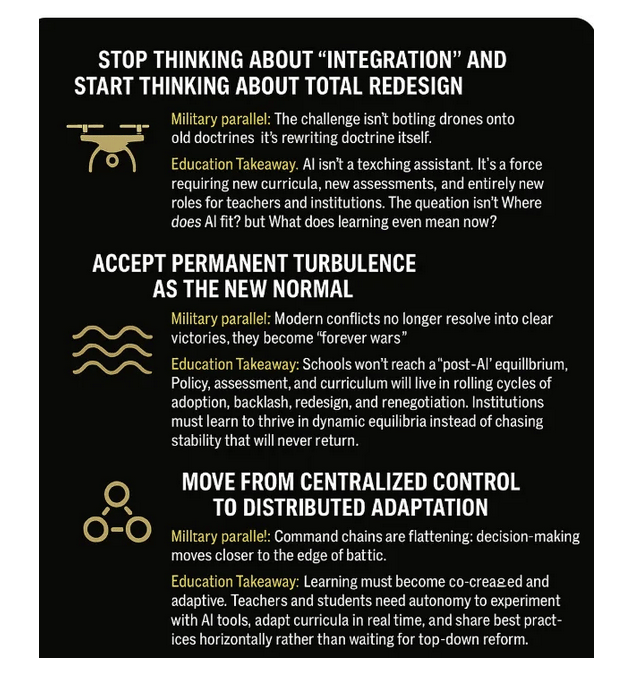- On Student Success
- Posts
- This Week in Student Success
This Week in Student Success
A mixed plate of worries and wins

Was this forwarded to you by a friend? Sign up for the On Student Success newsletter and get your own copy of the news that matters sent to your inbox every week.
I’m back home from Edinburgh, exhausted, a few pounds heavier, and happily intellectually stimulated. One of my favorite parts of traveling in the UK is the chance to order a ploughman’s lunch.

Perhaps it’s the variety, perhaps it’s the tasty things themselves, I am not certain. It is a little bit like what I am trying to do with these weekly posts (and the equivalent over at On EdTech), a variety of tasty morsels. But what happened this week in student success?
Stress tests for student success
The University of Melbourne’s Center for the Study of Higher Education—an excellent source of insights and research—published a report on a survey of university student well-being. They published it in June but I only got around to reading it this week!
The Uni Student Wellbeing Survey, administered at 11 Australian universities [snip] (between October 2023 – July 2024), asked undergraduate students to rate dimensions of their mental health, wellbeing and academic experiences. The Survey also elicited information about students’ life responsibilities, socio- demographic backgrounds, undergraduate experiences and study challenges.
Student mental health and well-being are among the issues that went under-discussed for years but are now central to student success. The Melbourne study offers much-needed insights into this area. I found especially useful their division of the concept into two distinct categories: psychological distress and psychological well-being.
Psychological Distress is measured by Kessler et al.’s (2002) Kessler-6 (K6), which assesses the presence and severity of symptoms associated with negative emotional states such as low mood, stress, anxiety and depression.
Psychological Wellbeing is measured by Diener et al.’s (2009) Flourishing scale (FS), which assesses the presence of positive emotions, positive functioning and social wellbeing, including optimism, self-esteem, sense of purpose and positive relationships.
Too often, mental health in student success gets treated as a single, oversimplified blob of symptoms. But everyone experiences distress at some point. The real questions are: how severe and how frequent is it, and what resources do students have to respond?
Overall, the researchers find that students cluster into distinct groups based on their reported levels of distress and well-being.
overall, 42.8% of students experienced at least some mental health and wellbeing (MHWB) difficulties:
• 12.6% reported High distress only
• 14.8% reported Low wellbeing only
• 15.4% reported both High distress and Low wellbeing – we refer to this group as experiencing Poor mental health and wellbeing (Poor MHWB).
Of the 57.2% of students who did not report MHWB difficulties:
• 35.2% of students were classified as Moderately well
• 22.0% were Thriving – that is, they reported Low distress and High wellbeing
At some level, this is better news than I expected. But as the researchers dug into the data, the implications for students in states of Poor MHWB are sobering but they make clear the fact that good mental health and well being are critical for student success and institutional value.
Student success: Only 53.4% of students with Poor MHWB feel confident they’ll complete their programs, and 43.3% have considered dropping out, more than double the overall student rate (20.9%).
Access and trust: Just 34.4% of Poor MHWB students say they have sufficient information about campus mental health resources, and fewer than half (42.7%) trust available student support services.
Perceived value: 58.0% of Poor MHWB students doubt whether their degree is worth the time, money, and effort (vs. 34.6% overall). Nearly half (49.6%) rate their overall university experience as “Poor” or “Fair,” compared with 26.1% overall.
These findings merit deeper study. I’d love to see institutions and organizations in the U.S. and U.K. run versions of this survey to sharpen our understanding of students’ mental health and well-being. Frankly, it would be far more valuable than yet another poll about how students are using AI.
Career dreams, mental health realities
College Futures and Gallup’s 2025 State of California Learners report paints an overall hopeful and positive picture of how students in California view higher education. To better understand the experiences of Californians without a college degree they conducted.
a statewide study of three populations: 1) currently enrolled students (without a degree), 2) adults who enrolled in a postsecondary degree or credential program but stopped out before completing it and 3) adults who have never enrolled in a degree or credential program.
The report underscores the continued, and even growing, importance of career considerations in driving students to enroll and persist in higher education. Institutions would be wise to give this even more attention.
I found College Futures’ breakdown of the obstacles students face, and the factors that lead them to stop out, especially insightful. Here are the reasons students reported considering stopping out or having stopped out recently.
The prominence of mental health, and the impact of starting a new job, in prompting students to consider or actually stop out is striking. I’m also struck by how many issues register at 10% or more on the chart.
Given my interest in EdTech, I was fascinated by the role that limited remote-learning options play in driving students to consider stopping out. When College Futures breaks down responses by age, the importance of flexibility for nontraditional students becomes even clearer.
It’s 16% for the overall population but jumps to 22% for students over 25. Flexibility isn’t just important, it’s increasingly central to student success, contributing directly to retention and persistence.
There is a wealth of information in the survey report and I have just scratched the surface, so do go give it a read.
Exclusive access
I grabbed this from LinkedIn, which is, these days, the only social media my own mental health and well-being will allow me to access, but I failed to note who posted it. And, of course, now I can’t find it. My apologies.

To be fair I believe that textbook spending has been going down for students, but it gave me a chuckle nonetheless.
The geography of physics
Last week I wrote about how access to specific humanities, social sciences, and arts subjects in the U.K. is increasingly limited for students outside major urban centers.
The problem is spreading across fields. The Institute of Physics surveyed physics department heads and found that the discipline faces enormous, and potentially catastrophic, cuts over the next few years. The survey underscores the scale and urgency of the challenge.
Physics Matters: Funding the Foundations of Growth found that more than a quarter (26%) of UK university physics departments surveyed could be shut down in the next two years. More than half (58%) expect degree courses to close within two years, 83% say they expect to see job losses in this period, and 84% say they already face financial challenges.
The problem extends beyond higher education. An earlier report found that more than a quarter of secondary schools in England lack a specialist physics teacher.
I find the cuts to physics in higher education alarming for two reasons. First, physics is a core STEM discipline, providing foundational building blocks for more applied knowledge. Second, while I’m an avid proponent of portfolio maintenance and of universities regularly reviewing their program mix, the scale of these cuts seems unreasonable and likely to cause real harm to higher education’s ability to deliver quality teaching and innovation, especially in STEM, and, as a consequence, to broader societal well-being.
In the U.S., we call this “eating the seed corn.” It’s never a good idea.
Education and war
Some might argue that “military education” is a contradiction in terms, but I’ve always been fascinated by what our sector can learn from the military, especially how to teach effectively under tight time constraints.
A newsletter post this week broadened my thinking. Over at Education Disrupted, Stefan Bauschard writes about how new technologies have upended the conduct of war and extends the analogy to higher education. Drawing on another post specifically about warmaking, Bauschard argues that formal militaries around the world now face a world in which the ways of making war have been profoundly changed.
Cheap, adaptive tools eroding expensive hierarchies and legacy systems.
Asymmetric actors changing the balance of power overnight.
Instability as the new baseline—a world of rolling disruptions rather than lasting resolutions
He traces each of these over to the education space, mapping the parallels and drawing out the implications.
If I wanted to be super-persnickety, I could argue the contrast between “then” and “now” is overstated, that outcomes of past wars were never so clear-cut, and that what looked like hierarchy was often much flatter, explicitly or in practice. I’ve read too much John Keegan and Rick Atkinson to think otherwise.
That said, this is a compelling way to capture the magnitude of the change while keeping it easy to grasp. I need to sit with it and think more.
Musical coda
While in Edinburgh, I managed to sneak away one night to the famed Sandy Bell’s pub, renowned for its live trad music. I did capture some video, though it’s not great, so here’s a representative snippet from someone else.
The main On Student Success newsletter is free to share in part or in whole. All we ask is attribution.
Thanks for being a subscriber.





